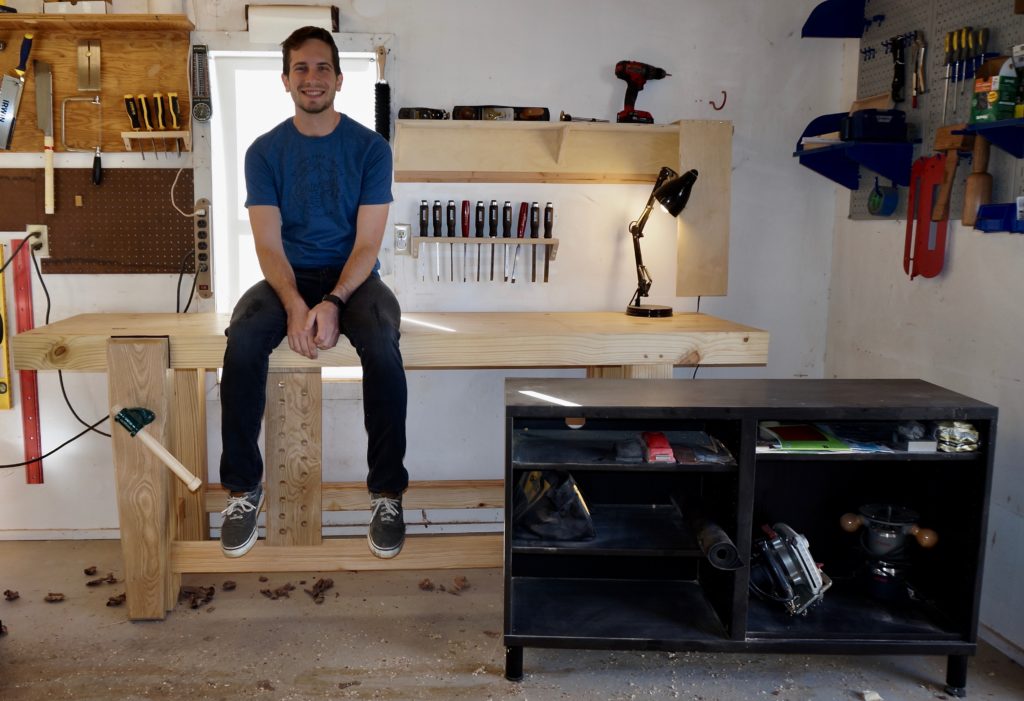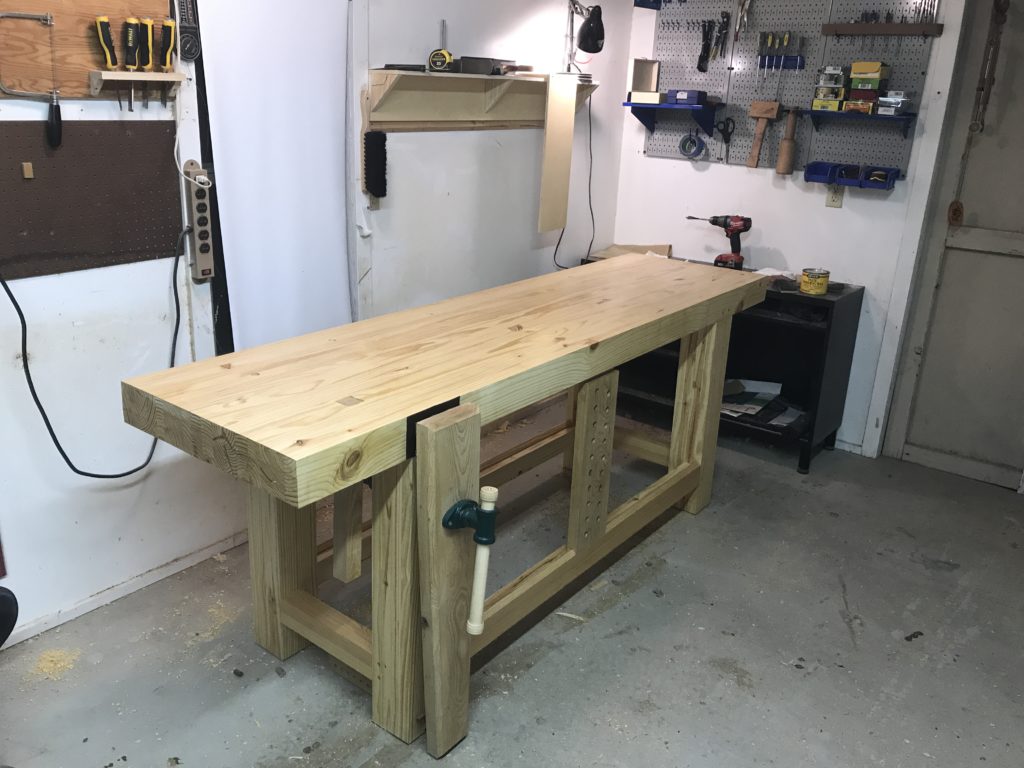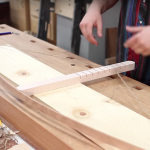We may receive a commission when you use our affiliate links. However, this does not impact our recommendations.
Editor’s note: Eric first shared this post on reddit.com/r/woodworking and I asked him to write a follow-up article on how he chose his workbench from “Workbenches Revised Edition: From Design & Theory to Construction & Use” by Christopher Schwarz (which is 50% off at the time of this writing!).

My first workbench was an Ikea TV stand that we put in our garage to save space in our apartment’s living room. The BESTÅ was never intended to be anything other than a thing to set a TV on, but it was what I had and we could still park in the garage with it in there, so I tried to make it work. However, there were several major problems. The BESTÅ was lightweight which made it slide and shake when handsawing or chiseling. I didn’t have a handplane at the time, but I can’t imagine that would have gone well at all. It was also short, which killed my back anytime I had to…well…use it for something other than a tool rest. Finally, it was difficult to clamp down anything, as only the front edge was exposed. I was usually able to find creative workholding solutions, but it slowed me down and made work more difficult. All in all, it was a mediocre TV stand and a terrible workbench, but it did show me the value of a good workbench and illuminated some attributes that might make a good workbench. When my wife and I bought a house with a small workshop in the back, I knew what my first project would be.
I planned my workbench by reading blogs, forums and other free online material which eventually led me to a comment on a Reddit post that recommended Chris Schwarz’s book “Workbenches: from Design and Theory to Construction and Use.” I ordered the book the same night and read it over the next week. I was so interested in the information and Chris’ presentation style that I carried it with me almost everywhere so I could read and think about what I wanted my workbench to be. In his book, Chris uses historical workbench research combined with modern practices and his own experience to explore and explain two different styles of workbench: the English and the French. I spent weeks going back and forth between the two styles.
There is a lot to consider when making a workbench, but most of it revolves around one question: What do you want to make? And honestly, I want to make everything. My list of woodworking goals includes tables, desks, chairs, a canoe, boxes and lamps, to name a few. With the goal of “build everything,” one of my biggest bench requirements was that it should be versatile and adaptable. In addition, I wanted it to be heavy, the right size for me and the ultimate clamping surface: the opposite of the BESTÅ. Ultimately, I was drawn to the French workbench. It is big and heavy. The legs are flush with the top for easy clamping. And most importantly, it is wide open for modifications as my workholding needs evolve.
When I started the workbench, I was a very green woodworker and building the French workbench requires laminating the top and legs, creating mortise-and-tenon joints, drawboring and other woodworking techniques I had not yet tried. I was intimidated by the challenge and the amount of work it would take, but I decided it was better to have those first experiences on something that would get beat up in the shop instead of a piece of furniture I was hoping to display in my home. Chris also makes the bench less intimidating by explaining how to use inexpensive Southern yellow pine from the home center (if you’re in the Southeast) to build a high-quality bench. I found Chris’s book was very accessible for someone of my skillset. Could it have been done better and faster if I had more experience? Of course. But I also believe I could have done it with less experience. My build was spread out several months where I worked in concentrated spurts with little activity in between.
My biggest challenges in building this beast mostly dealt with the size and weight of the glue-ups. It took some practice before I was able to do one of the laminations without panicky moments and tons of wasted glue. Throughout the build, I saw the level of precision in my work greatly increase. I quickly improved my ability to prepare stock, layout joinery, work a handplane, and sharpen my tools. For a novice building a bench like this, there were more lessons learned than I could reasonably be put into a blog post. To anyone out there considering a bench like this, but unsure about the time, effort or skill level: All I can say is that it was absolutely worth it for me and if I was starting over, I would do it just the same.
In the months since I completed my bench, I put the bench to use building a table for my record player and some small boxes. The bench has held my work while I hand cut mortises, tenons and dovetails. I have found the leg vice to be extremely helpful. Working with the bench for a few months now, I can’t imagine working without it.
– Eric Greuner
P.S. I still use the BESTÅ, but just for storage.
Workbenches Revised Edition: From Design & Theory to Construction & Use
This revised edition of Christopher Schwarz’s classic book on workbenches examines the fundamental rules of good bench design. At the end of the day a workbench is a tool for holding wood in as many orientations as possible. Every workbench should be able to easily work the edges, faces and ends of boards. With this core function in mind, some of the best workbenches are the ones that have been proven throughout history. This book looks at workbench designs from the 18th and 19th centuries that were utterly fantastic to use. These old-school benches are simpler than modern benches, easier to build and surprisingly perfect for both power and hand tools. In addition to an in-depth examination of bench design, this book demystifies complex vises and ways of holding work.
Here are some supplies and tools we find essential in our everyday work around the shop. We may receive a commission from sales referred by our links; however, we have carefully selected these products for their usefulness and quality.











Good stuff, Eric! I’m in a small apartment myself, but if we do follow up on our almost-weekly threats to “move to the country” (aka leave NYC), I’d like to tackle a similar bench. Congratulations!
(Side note: PW crew, can someone implement a more user-friendly photo gallery plugin for articles like these? I’m sure I’m probably not raising a new point here, or one of which you are unaware….)
Great post! This mirrors my own experience, right down to wanting to build everything. It’s the ideal first project. A taste of a variety joints and on a large scale. Big pieces easier to handle and their joints slightly forgiving as you’ll likely be making plenty of little mistakes. Not to mention all the refinements to your tools and techniques that go along with it. And, most importantly, the product of all this effort is the foundation of all future projects. I’d recommend building a proper bench to anyone starting out no matter which style
I built my first bench two years ago. Only after completing a few different projects did I appreciate how a bench can be purpose built for a certain style of woodworking. I built a Moravian bench as per Will Myers design as I’ll need to move it now and again. It is a world apart working on a solid flat bench. So glad I made it.